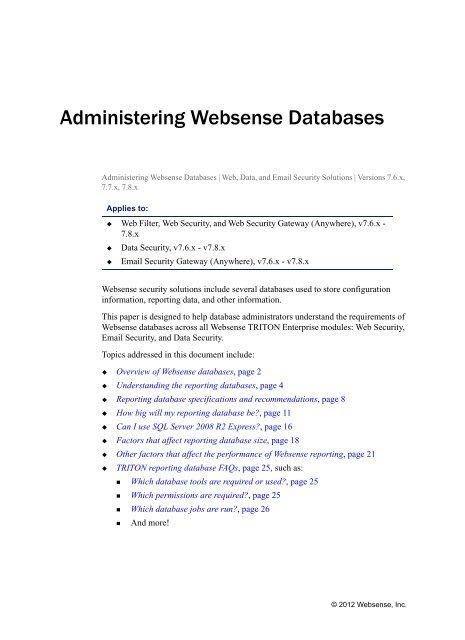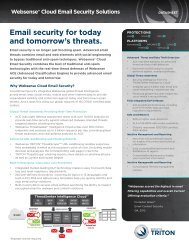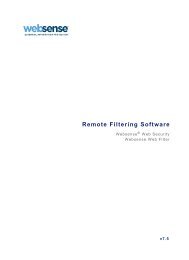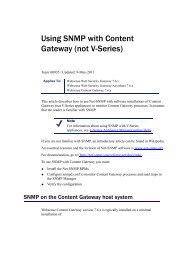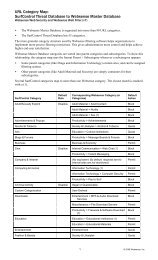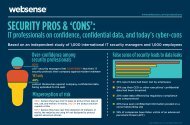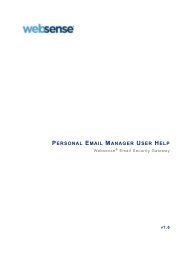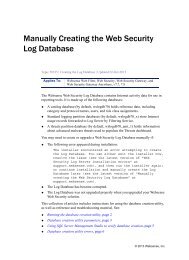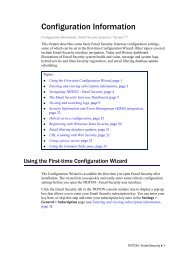Administering Websense Databases, v7.6.x and 7.7.x
Administering Websense Databases, v7.6.x and 7.7.x
Administering Websense Databases, v7.6.x and 7.7.x
You also want an ePaper? Increase the reach of your titles
YUMPU automatically turns print PDFs into web optimized ePapers that Google loves.
<strong>Administering</strong> <strong>Websense</strong> <strong>Databases</strong><strong>Administering</strong> <strong>Websense</strong> <strong>Databases</strong> | Web, Data, <strong>and</strong> Email Security Solutions | Versions 7.6.x,<strong>7.7.x</strong>, 7.8.xApplies to: Web Filter, Web Security, <strong>and</strong> Web Security Gateway (Anywhere), <strong>v7.6.x</strong> -7.8.x Data Security, <strong>v7.6.x</strong> - v7.8.x Email Security Gateway (Anywhere), <strong>v7.6.x</strong> - v7.8.x<strong>Websense</strong> security solutions include several databases used to store configurationinformation, reporting data, <strong>and</strong> other information.This paper is designed to help database administrators underst<strong>and</strong> the requirements of<strong>Websense</strong> databases across all <strong>Websense</strong> TRITON Enterprise modules: Web Security,Email Security, <strong>and</strong> Data Security.Topics addressed in this document include: Overview of <strong>Websense</strong> databases, page 2 Underst<strong>and</strong>ing the reporting databases, page 4 Reporting database specifications <strong>and</strong> recommendations, page 8 How big will my reporting database be?, page 11 Can I use SQL Server 2008 R2 Express?, page 16 Factors that affect reporting database size, page 18 Other factors that affect the performance of <strong>Websense</strong> reporting, page 21TRITON reporting database FAQs, page 25, such as:• Which database tools are required or used?, page 25• Which permissions are required?, page 25• Which database jobs are run?, page 26• And more!© 2012 <strong>Websense</strong>, Inc.
<strong>Administering</strong> <strong>Websense</strong> <strong>Databases</strong>Overview of <strong>Websense</strong> databases<strong>Administering</strong> <strong>Websense</strong> <strong>Databases</strong> | Web, Data, <strong>and</strong> Email Security Solutions | Versions 7.6.x,<strong>7.7.x</strong>, 7.8.xApplies to: Web Filter, Web Security, <strong>and</strong>Web Security Gateway(Anywhere), <strong>v7.6.x</strong> - v7.8.x Data Security, <strong>v7.6.x</strong> - v7.8.x Email Security Gateway(Anywhere), <strong>v7.6.x</strong> - v7.8.xIn this topic<strong>Websense</strong> Data SecurityFingerprint Database, page 3<strong>Websense</strong> TRITON solutions use a variety of databases for different purposes:configuration information, reporting data, URL categorization, fingerprinting, <strong>and</strong>forensics. Several data formats are used, including SQL, PostgreSQL, <strong>and</strong> <strong>Websense</strong>proprietary formats.These databases include:Database<strong>Websense</strong> reporting databases<strong>Websense</strong> TRITON SettingsDatabase<strong>Websense</strong> Master DatabaseDescriptionWeb, Data, <strong>and</strong> Email SecuritySQL Server databases that store reporting <strong>and</strong> loggingdata for individual TRITON modules. The DataSecurity reporting database also stores configurationdata.See Underst<strong>and</strong>ing the reporting databases, page 4.Web, Data, <strong>and</strong> Email SecurityPostgreSQL database that stores global configuration<strong>and</strong> infrastructure settings that affect all TRITONmodules. It is installed automatically on the TRITONmanagement server <strong>and</strong> requires no administratorconfiguration.Web SecurityProprietary database that contains URL categories <strong>and</strong>protocol definitions, as well as supporting information,such as risk class groupings.A copy of the Master Database resides on each FilteringService machine. By default, a full update is performeddaily. Incremental updates can occur much morefrequently if they are enabled on the Settings >General > Database Download page in Web Securitymanager.See “The <strong>Websense</strong> Master Database” in the v7.6, v7.7,or v7.8 Web Security Help for further details.2 <strong>Websense</strong> TRITON Enterprise
<strong>Administering</strong> <strong>Websense</strong> <strong>Databases</strong>Database<strong>Websense</strong> RTM Database<strong>Websense</strong> Web SecurityForensics Database<strong>Websense</strong> Data SecurityFingerprint Database<strong>Websense</strong> Data SecurityForensics DatabaseDescriptionWeb SecurityHolds <strong>and</strong> organizes filtering data for display in Real-Time Monitor. This is an independent database (nothosted on SQL Server) installed with each RTM Client<strong>and</strong> RTM Server instance.Administrators can specify when Real-Time Monitorcaptures data on the Settings > Reporting >Preferences page in Web Security manager. No otheraspect of database behavior is configurable.v7.7 <strong>and</strong> later onlyWeb Security Gateway <strong>and</strong> Gateway AnywhereStores details about files that may be associated withadvanced malware threat activity in your network.Enable or disable the forensics repository, <strong>and</strong> configureits location <strong>and</strong> size on the Settings > Reporting >Dashboard page in Web Security manager.See “Configuring Dashboard reporting data” in the v7.7or v7.8 Web Security Help for details.Data SecurityStores Data Security fingerprints.See <strong>Websense</strong> Data Security Fingerprint Database,page 3.Data SecurityContains information about DLP <strong>and</strong> discoverytransactions that resulted in incidents, such as thecontents of an email body, including the From:, To:, <strong>and</strong>Cc: fields, as well as actual attachments. Transactionscan also include Web posts, endpoint operations, <strong>and</strong>discovered as well as other events. For transactions thatoccurred on a Web channel, the forensics might includethe URL category property. For discovery transactions,forensics might include the host name <strong>and</strong> file name.Configure the size <strong>and</strong> location of the forensicsrepository in Data Security manager. Navigate to theSettings > Deployment > System Modules page <strong>and</strong>click Forensics Repository under the managementserver.<strong>Websense</strong> Data Security Fingerprint DatabaseOne of the ways that you can classify data in <strong>Websense</strong> Data Security is by“fingerprinting” it. This lets Data Security detect sensitive information despitemanipulation, reformatting, or other modification. Fingerprints enable the protectionof whole or partial documents, antecedents, <strong>and</strong> derivative versions of the protectedinformation, as well as snippets of the protected information whether cut <strong>and</strong> pasted orretyped.<strong>Administering</strong> <strong>Websense</strong> <strong>Databases</strong> 3
<strong>Administering</strong> <strong>Websense</strong> <strong>Databases</strong>When you fingerprint data, the fingerprints are stored in the Data Security FingerprintDatabase on the TRITON management server <strong>and</strong> pushed to other Data Securitycomponents for fast analysis on those machines.To tune performance, you can configure the disk space <strong>and</strong> cache size of the databaseon the management server in Data Security manager. To do so:1. Log onto the TRITON console <strong>and</strong> select the Data Security module.2. Navigate to Settings > Deployment > System Modules.3. Select Primary Fingerprint Repository under the management server.4. Adjust the maximum disk space <strong>and</strong> cache size as needed.Secondary repositories are maintained by <strong>Websense</strong> Content Gateway <strong>and</strong> EmailSecurity Gateway. You can configure Data Security to detect fingerprints fromrepositories local to those machines (best practice) or from a remote machine, such asthe management server.Periodically, you must synchronize the fingerprints in the secondary repositories withthe ones on the management server. How often you synchronize depends on yourbusiness needs. For best performance, select a time with low traffic volume.To configure these settings:1. Navigate to Settings > Deployment > System Modules.2. Select Secondary Fingerprint Repository under the component or solution ofinterest.3. Choose the repository from which to detect fingerprints.4. Set the maximum cache size <strong>and</strong> synchronization frequency as needed.See “Configuring the fingerprint repository” in the v7.6, v7.7 or v7.8 Data SecurityHelp for instructions on configuring these settings.Underst<strong>and</strong>ing the reporting databases<strong>Administering</strong> <strong>Websense</strong> <strong>Databases</strong> | Web, Data, <strong>and</strong> Email Security Solutions | Versions 7.6.x,<strong>7.7.x</strong>, 7.8.xApplies to:Web Filter, Web Security, <strong>and</strong>Web Security Gateway(Anywhere), <strong>v7.6.x</strong> - v7.8.xData Security, <strong>v7.6.x</strong> - v7.8.xEmail Security Gateway(Anywhere), <strong>v7.6.x</strong> - v7.8.xIn this topicSQL Server Express on theTRITON management server,page 7SQL Server on another machine,page 7Each TRITON reporting database stores the logging data collected by a specificTRITON solution: Web Security, Data Security, or Email Security.4 <strong>Websense</strong> TRITON Enterprise
<strong>Administering</strong> <strong>Websense</strong> <strong>Databases</strong>Web Security Log Database stores Internet request data collected by Log Server,such as the source, destination, time, category, risk class, action (also calleddisposition), bytes sent <strong>and</strong> received, <strong>and</strong> so on for use by Web Security reportingtools.Log Server receives information about Internet activity from Filtering Service <strong>and</strong>initially stores it locally:Whenever it is able, Log Server forwards the cache files to the Log Database,where the ETL job processes them into log records in a database partition:Email Security Log Database stores records of email traffic <strong>and</strong> the associatedfiltering actions on that traffic. Email Security reporting uses this information togenerate dashboard status charts <strong>and</strong> email activity reports showing, for example,the size <strong>and</strong> volume of messages processed, message filtering disposition, <strong>and</strong>email source <strong>and</strong> destination.<strong>Administering</strong> <strong>Websense</strong> <strong>Databases</strong> 5
<strong>Administering</strong> <strong>Websense</strong> <strong>Databases</strong>Log <strong>and</strong> quarantine data are recorded as follows:Data Security Incident <strong>and</strong> Configuration Database stores information aboutemail, Web, <strong>and</strong> other traffic that resulted in data loss prevention (DLP) policybreaches, such as the source, destination, time, status, <strong>and</strong> severity of each breach.It also stores Data Security policy configuration <strong>and</strong> system settings.TRITON reporting databases are all hosted by Microsoft SQL Server. They may behosted by the same installation <strong>and</strong> instance, or by different installations or instances.Although Microsoft SQL 2008 R2 Express (SQL Server Express) is packaged with<strong>Websense</strong> software, enterprises with high transaction volume should purchaseMicrosoft SQL Server St<strong>and</strong>ard or Enterprise. (See Can I use SQL Server 2008 R2Express?, page 16 for guidance.)When you install <strong>Websense</strong> software, you can either install SQL Server Express onthe TRITON management server or connect to an existing SQL Server instance onanother machine.Related topics: Reporting database specifications <strong>and</strong> recommendations, page 8 How big will my reporting database be?, page 11 Can I use SQL Server 2008 R2 Express?, page 16 Factors that affect reporting database size, page 186 <strong>Websense</strong> TRITON Enterprise
<strong>Administering</strong> <strong>Websense</strong> <strong>Databases</strong> Other factors that affect the performance of <strong>Websense</strong> reporting, page 21 TRITON reporting database FAQs, page 25SQL Server Express on the TRITON management serverFor smaller deployments (up to 500 users), TRITON reporting databases can beinstalled on the TRITON management server.The TRITON Unified Security installer installs SQL Server 2008 R2 Express (32-bit)to host reporting databases when you select Install SQL Server Express on thismachine during installation. SQL Server 2008 R2 Express is the only version of SQLServer that may reside on the TRITON management server.If you are upgrading from a previous version of Web Security <strong>and</strong> have a differentversion of SQL Server installed on the TRITON management server machine, moveyour reporting database to a different machine for improved performance <strong>and</strong> a betteroverall product experience.SQL Server Express can run on the following Windows platforms. Note that WindowsServer 2008 R2 <strong>and</strong> later support all TRITON modules.WindowsServer 2003*WindowsServer 200832-bitWindowsServer 2008R2Data Security x (v7.6 only) x xWeb Security x (v7.6 only) x x xEmail Security x xWindowsServer 2012* In <strong>v7.6.x</strong>, Windows 2003 is supported for a single TRITON module (Web Security orData Security), but not for a combination of modules. Windows Server 2003 is notsupported from v7.7 onwards.SQL Server on another machineIn medium <strong>and</strong> larger deployments (over 500 users), the best practice is to hostTRITON reporting databases on a St<strong>and</strong>ard or Enterprise installation of MicrosoftSQL Server. SQL Server typically resides on a dedicated machine. It may hostdatabases for third-party applications, in addition to the <strong>Websense</strong> databases.When installing <strong>Websense</strong> software, you are prompted to provide the IP address orhostname of the SQL Server machine. You may also specify:An instance name(v<strong>7.7.x</strong> <strong>and</strong> later) The port to use for SQL Server communication(v<strong>7.7.x</strong> <strong>and</strong> later) Whether or not to encrypt communication with SQL Server<strong>Administering</strong> <strong>Websense</strong> <strong>Databases</strong> 7
<strong>Administering</strong> <strong>Websense</strong> <strong>Databases</strong>The following databases are supported. Note that you cannot use SQL Server 2005 forthe reporting database if you plan to run Data Security or Email Security.SQLServer2005 SP4*SQLServer2008**SQLServer2008 R2ExpressSQLServer2008 R2***SQLServer2012Data Security x x x xWeb Security x x x x xEmail Security x x x x*All editions except Web, Express, <strong>and</strong> Compact; all service packs; 32- <strong>and</strong> 64-bit, excludingIA64. Only supported for 7.6.x <strong>and</strong> <strong>7.7.x</strong>.** All editions except Web, Express, <strong>and</strong> Compact; all service packs, 32- <strong>and</strong> 64-bit,excluding IA64.***All editions except Web <strong>and</strong> Compact; all service packs, 32- <strong>and</strong> 64-bit, excluding IA64.Clustering is supported for all supported versions of SQL Server noted in the tableabove. See Can <strong>Websense</strong> reporting databases be hosted in a SQL Server cluster?,page 29.Reporting database specifications <strong>and</strong>recommendations<strong>Administering</strong> <strong>Websense</strong> <strong>Databases</strong> | Web, Data, <strong>and</strong> Email Security Solutions | Versions 7.6.x,<strong>7.7.x</strong>, 7.8.xApplies to:Web Filter, Web Security, <strong>and</strong>Web Security Gateway(Anywhere), <strong>v7.6.x</strong> - v7.8.xData Security, <strong>v7.6.x</strong> - v7.8.xEmail Security Gateway(Anywhere), <strong>v7.6.x</strong> - v7.8.xIn this topic Hardware specifications, page 9 RAM, page 9 Disk considerations, page 9 Virtualization, page 10The performance of <strong>Websense</strong> reporting solutions is heavily dependent on the SQLServer, <strong>and</strong> the configuration of its underlying resources. The more you invest in thesystem, the better it will perform.For optimal results, host the reporting databases on Windows Server 2008 R2Enterprise Edition <strong>and</strong> SQL Server 2008 R2 Enterprise Edition.Also consider the factors that follow when designing your database system.8 <strong>Websense</strong> TRITON Enterprise
<strong>Administering</strong> <strong>Websense</strong> <strong>Databases</strong>Hardware specificationsRAMUse hardware that meets or exceeds Microsoft’s recommended (not minimum)hardware requirements for SQL Server.Microsoft SQL Server 2012:http://technet.microsoft.com/en-us/library/ms143506(v=sql.110).aspxMicrosoft SQL Server 2008 R2:http://technet.microsoft.com/en-us/library/ms143506(v=sql.105).aspxMicrosoft SQL Server 2008:http://technet.microsoft.com/en-us/library/ms143506%28SQL.100%29.aspxMicrosoft SQL Server 2005 SP4 (Web Security <strong>v7.6.x</strong> or v<strong>7.7.x</strong> only):http://msdn.microsoft.com/en-us/library/ms143506%28v=sql.90%29.aspxThe reports that administrators generate often require that SQL Server be capable ofloading, summarizing, <strong>and</strong> processing large amounts of data across multiple physicaldatabases. Even if your organization doesn’t run complex reports, if there are multiplereporting administrators, the system may frequently be asked to generate severalreports concurrently. This places high dem<strong>and</strong>s on system memory. As a result,increasing RAM may provide noticeable performance improvements.Keep in mind that the operating system version <strong>and</strong>/or the version of SQL Server maylimit the amount of physical RAM that can be used by the system. For example,Windows Server 2008 St<strong>and</strong>ard Edition supports SQL Server 2008 running with amaximum of 32 GB of RAM, no matter how much is available in hardware.Consult your operating system <strong>and</strong> SQL Server documentation to ensure that youutilize the maximum physical RAM possible in your chosen system.See Other factors that affect the performance of <strong>Websense</strong> reporting, page 21, forguidance on how the memory dem<strong>and</strong>s of <strong>Websense</strong> reporting may increase ordecrease based on how you use it.Disk considerationsBecause database operations are often I/O-intensive, a faster, dedicated disk canimprove how the database performs. Use high-performance disks whenever possibleto ensure optimum database operation.SQL Server performs better when there is minimal disk contention. For bestperformance, place tempdb files, reporting database files, <strong>and</strong> log files on separatephysical drives with dedicated controllers. Follow SQL Server recommendations forinstalling <strong>and</strong> configuring SQL Server.<strong>Administering</strong> <strong>Websense</strong> <strong>Databases</strong> 9
<strong>Administering</strong> <strong>Websense</strong> <strong>Databases</strong>RAID controllers provide disk redundancy <strong>and</strong> can increase disk throughput byspreading I/O activity across multiple physical disks. If you have a high-dem<strong>and</strong>system, for peak performance, use a RAID 10 configuration managed by a hardwarebasedRAID controller. (For systems with a lower I/O profile, RAID 5 may providesufficient performance at a lower cost.)For best performance:Use a hardware RAID controller, not software.Max out the RAID controller RAM cache.Use multi-channel links between the RAID controller <strong>and</strong> disk shelf or SAN.Separate the transaction logs <strong>and</strong> database files onto separate disks, arrays, orLUNs.This means separate spindles or RAID arrays, not just separate logical drives.If you are using a SAN, map the physical <strong>and</strong> logical LUNs to ensure you arereading <strong>and</strong> writing key components to separate physical drives. (This is to enablemultiple parallel IO operations.)Make sure that different database files are spread across different disks whereverpossible. For very large deployments, for example, plan to map wslogdb70_1 tospindle 1, wslogdb70_2 to spindle 2, <strong>and</strong> so on.The disk stripe size (how files are stored across striped arrays) is also critical <strong>and</strong>is a function of both the typical read/write size <strong>and</strong> the total database size. Contactto Microsoft or a sizing specialist for guidance.In large deployments, map different disks, arrays, or LUNs across differenthardware controllers to maximize parallel operations <strong>and</strong> controller cache usage.If you are using spinning disks, lower seek times are better.Virtualization<strong>Websense</strong> products can be deployed on virtualized systems. Be aware that the use ofvirtualization can affect system performance. Expect up to 25% performancedegradation.For specifics on virtualization support, see the article Virtual Machine Support,available from support.websense.com.Note that Microsoft has its own support guidelines for SQL Server, which can befound here:http://support.microsoft.com/?id=95689310 <strong>Websense</strong> TRITON Enterprise
<strong>Administering</strong> <strong>Websense</strong> <strong>Databases</strong>How big will my reporting database be?<strong>Administering</strong> <strong>Websense</strong> <strong>Databases</strong> | Web, Data, <strong>and</strong> Email Security Solutions | Versions 7.6.x<strong>7.7.x</strong>, 7.8.xApplies to:Web Filter, Web Security, <strong>and</strong>Web Security Gateway(Anywhere), <strong>v7.6.x</strong> - v7.8.xData Security, <strong>v7.6.x</strong> - v7.8.xEmail Security Gateway(Anywhere), <strong>v7.6.x</strong> - v7.8.xIn this topicWeb Security size estimates, page11Email Security size estimates,page 13Data Security size estimates, page15When estimating the size of your TRITON reporting databases, keep the followingfactors in mind:Data Security logs only data violations, which typically represent a small fractionof your total Web <strong>and</strong> email volume.Email Security logs detected spam <strong>and</strong> quarantined email messages, whichtypically represent up to 90% of your email volume.Web Security logs all web transactions, which typically represent about 40% ofyour total web traffic volume when visits (the default) are recorded rather thanhits. See Web Security visits, consolidation, <strong>and</strong> full URL logging, page 18, fordetails.WarningThese are averages calculated across a large number of<strong>Websense</strong> customers with widely varying deployments.While these numbers are useful for estimation, pleaseanalyze your system’s actual performance after a few daysor weeks to reassess your database sizing needs.Web Security size estimatesThe table below provides some general rules to help estimate the size of your WebSecurity Log Database, based on whether you are recording visits or hits. <strong>and</strong> URLhostnames or full URLs. By default, visits <strong>and</strong> URL hostnames are recorded.URL hostnamesFull URL loggingVisits 3 MB per user per month 4.5 MB per user per monthHits 8 MB per user per month 12 MB per use per month<strong>Administering</strong> <strong>Websense</strong> <strong>Databases</strong> 11
<strong>Administering</strong> <strong>Websense</strong> <strong>Databases</strong>The size increase that accompanies full URL logging can vary widely based on thetype of URL being logged. For example, the following types of traffic tend to generatevery long URLs:Research database search <strong>and</strong> results URLsSearch stringsSocial networking sitesOnline apps <strong>and</strong> gamesConsider the example of an organization with 7500 users who wants to store data for 3months, using monthly database partition rollover.Visits are enabledFull URL logging is enabledThe Internet access policy is permissiveA high percentage of Web traffic includes longer than average URLs (socialnetworking sites <strong>and</strong> online games)Based on this information, estimate 6 MB of data stored per user per month.Because rollover is monthly, it is necessary to allocate enough space to hold up to 4months of data. (This ensures that it is always possible to report on 3 months of data,even during the first days or weeks of the most recent month.)To start, therefore, 180 GB would be needed for the database logging partitions (notincluding the catalog database <strong>and</strong> AMT partition).6 MB * 7500 users * 4 months = 180 GBIn addition, calculate space for the following:Database transaction logs, whose size depends on the recovery model youchoose.• For full recovery (not recommended), allow for the same size as the data itself(180 GB in our example).• For simple recovery, the log volume depends on the amount of databaseactivity. Allow roughly 30 percent of the size of an active database partition.In our example, the total size of 4 full partitions is 180 GB, so each partition is 45GB in size. So for simple recovery:0.3 * 45 GB = 13.5 GBNote that this space is used only while data is being logged to the database.Inactive partitions, for example, have minimal transaction log activity. Likewise,during are time periods in which little or no Internet activity is being recorded, thetransaction log is very small.Temporary (tempdb) storage is used heavily during report generation <strong>and</strong> whenthe maintenance job is reindexing the database. The amount of tempdb spacerequired depends heavily on the types of reports being generated.In most environments, it is sufficient to allow twice the size of a partition:45 * 2 = 90 GB12 <strong>Websense</strong> TRITON Enterprise
<strong>Administering</strong> <strong>Websense</strong> <strong>Databases</strong>Temporary database (tempdb) transaction logs take up about 20 percent of thetempdb storage size. In our example:0.2 * 90 GB = 18 GBThe total space required for the Web Security Log Database in our example, then, is:180 GB + 13.5 GB + 90 GB + 18 GB = 301.5 GBTipAs a best practice, record visits rather than hits to reducesignificantly the amount of storage space required.See Factors that affect reporting database size, page 18, for an explanation of the<strong>Websense</strong> Web Security visits algorithm, other data reduction options, <strong>and</strong> the fullURL logging setting.Email Security size estimatesFor best practice in v7.7 <strong>and</strong> later, allow 1-3 MB per user per month when estimatingthe size of your <strong>Websense</strong> Email Security Log Database.For illustration, assume there will be 2 MB of data per user per month for 7500 users.Data will be kept for 3 months, with a scheduled monthly partition rollover.Because rollover is monthly, it is necessary to allocate enough space to hold up to 4months of data. (This ensures that it is always possible to report on 3 months of data,even during the first days or weeks of the most recent month.)This means that you would need 225 GB to start:2 MB * 7500 users * 4 months = 60 GBIn addition, you need to calculate space for the following:The database transaction logs, whose size depends on the recovery model youchoose.• For full recovery (not recommended), allow for the same size as the data itself(60 GB in our example).• For simple recovery, the log volume depends on the amount of databaseactivity. Allow roughly 30 percent of the size of the available data.0.3 * 60 GB = 18 GBTemporary database (tempdb) storage is used heavily during report generation.The amount of tempdb space required depends on the reports being run. As a bestpractice, allow the size of the logged data for temporary storage. In our example:60 GBTemporary database (tempdb) transaction logs take up about 20 percent of thetempdb storage size. In our example:0.2 * 60 GB = 12 GB<strong>Administering</strong> <strong>Websense</strong> <strong>Databases</strong> 13
<strong>Administering</strong> <strong>Websense</strong> <strong>Databases</strong>The total space required in our example, then, is:60 GB + 18 GB + 60 GB + 12 GB = 150 GBUse the following tables to estimate storage space required for 30 days’ worth of databased on email volume.The same requirements for partitions, logs, <strong>and</strong> temporary databases apply.The estimates assume an average of 5 recipients per email message.With the Email Security Gateway Anywhere hybrid service enabled: Version 7.610 msg/user/day50 msg/user/day100 msg/user/day200 msg/user/day400 msg/user/day500 users 200 MB 1000 MB 2000 MB 4100 MB 8300 MB1000 users 400 MB 2000 MB 4100 MB 8300 MB 16700 MB2000 users 800 MB 4100 MB 8300 MB 16700 MB 33500 MB5000 users 2000 MB 10500 MB 20900 MB 41900 MB 83700 MB Version 7.710 msg/user/day50 msg/user/day100 msg/user/day200 msg/user/day400 msg/user/day500 users 600 MB 3300 MB 6600 MB 13300 MB 26700 MB1000 users 1300 MB 6600 MB 13300 MB 26700 MB 53400 MB2000 users 2600 MB 13300 MB 26700 MB 53400 MB 106800MB5000 users 6600 MB 33400 MB 66800 MB 133600MB267200MBWithout the hybrid service: Version 7.610 msg/user/day50 msg/user/day100 msg/user/day200 msg/user/day400 msg/user/day500 users 400 MB 2300 MB 4600 MB 9200 MB 18400 MB1000 users 900 MB 4600 MB 9200 MB 18400 MB 36900 MB2000 users 1800 MB 9200 MB 18400 MB 36900 MB 73800 MB5000 users 4600 MB 23100 MB 46100 MB 92200 MB 184500 MB14 <strong>Websense</strong> TRITON Enterprise
<strong>Administering</strong> <strong>Websense</strong> <strong>Databases</strong> Version 7.710 msg/user/day50 msg/user/day100 msg/user/day200 msg/user/day400 msg/user/day500 users 500 MB 2600 MB 5200 MB 10400 MB 20900 MB1000 users 1000 MB 5200 MB 10400 MB 20900 MB 41800 MB2000 users 2000 MB 10400 MB 20900 MB 41800 MB 83600 MB5000 users 5200 MB 26100 MB 52200 MB 104500MB209000MBFor version 7.6, the calculations used are:With the hybrid service:(0.01436+0.0055* RECIPIENT)* SPEED * USERWithout the hybrid service:(0.03023+0.0124* RECIPIENT)* SPEED * USERFor version 7.7, the calculations used are:With the hybrid service:(0.01622+0.02348* RECIPIENT)* SPEED * USERWithout the hybrid service:(0.0384+0.01322* RECIPIENT)* SPEED * USERIn both sets of calculations:USER represents the total number of users.RECIPIENT is the average number of recipients for each message.SPEED is the average message volume for each user per day.Note that the Email Security Gateway hybrid service drops or blocks the followingtypes of email before they reach on-premises components:Email that comes from known bad (blacklisted) sourcesEmail that has a very high spam score in the cloudThis significantly reduces the amount of data stored in the Email Security LogDatabase, as shown in the examples above.Data Security size estimatesThe <strong>Websense</strong> Data Security Incident <strong>and</strong> Configuration Database is different fromthe Web <strong>and</strong> Email Security Log <strong>Databases</strong> in that it stores both configuration <strong>and</strong> log<strong>Administering</strong> <strong>Websense</strong> <strong>Databases</strong> 15
<strong>Administering</strong> <strong>Websense</strong> <strong>Databases</strong>data. In addition, it logs only policy violations, not all events. In order to estimate thepotential size of the Incident <strong>and</strong> Configuration Database, consider the following:FeatureDiscovery incidents(not st<strong>and</strong>ard with <strong>Websense</strong>TRITON Enterprise)Network <strong>and</strong> endpoint incidentsUser directory import dataConfiguration dataImpact on Database Size14 KB per incidentTypically, no more than 3.5 GB total10 KB per incidentTypically, 30 KB per user per month8 KB per recordTypically, no more than 1 GB total200 MBAs a general guideline, it is unlikely that your Data Security Incident <strong>and</strong>Configuration Database will require more than 9 GB of storage total, no matter howmany users are in your environment.The volume of configuration <strong>and</strong> incident data varies based on your use of DataSecurity features as explained in Factors that affect reporting database size, page 18.Can I use SQL Server 2008 R2 Express?<strong>Administering</strong> <strong>Websense</strong> <strong>Databases</strong> | Web, Data, <strong>and</strong> Email Security Solutions | Versions 7.6.x<strong>7.7.x</strong>, 7.8.xApplies to: Web Filter, Web Security, <strong>and</strong> Web Security Gateway (Anywhere), <strong>v7.6.x</strong> -7.8.x Data Security, <strong>v7.6.x</strong> - v7.8.x Email Security Gateway (Anywhere), <strong>v7.6.x</strong> - v7.8.xMicrosoft SQL Server 2008 R2 Express is bundled into the <strong>Websense</strong> TRITONUnified Installer.Regardless of the resources available on the machine hosting the database engine,Microsoft limits the resources that SQL Server 2008 R2 Express can use to:1 GB of RAM1 physical CPU10 GB of data per databaseThis results in practical limits on the amount of data that can be stored in SQL Server2008 R2 Express, while still maintaining acceptable performance when generatingreports <strong>and</strong> processing log data. For best performance, no more than 30 GB of data16 <strong>Websense</strong> TRITON Enterprise
<strong>Administering</strong> <strong>Websense</strong> <strong>Databases</strong>should be stored in SQL Server 2008 R2 Express across all <strong>Websense</strong> modules. Thesizing recommendations below are based on this assumption.For an explanation of particular dem<strong>and</strong>s that <strong>Websense</strong> reporting places on availablememory, see Other factors that affect the performance of <strong>Websense</strong> reporting, page21.Use the charts below to see how much data you can store using SQL Server Expressbased on the <strong>Websense</strong> module or modules you are using. You can then determine ifthat limit still meets your data retention requirements. If so, you can use SQL Server2008 R2 Express.NoteSt<strong>and</strong>alone Data Security installations can support up to5000 users with SQL Server 2008 R2 Express.Users Web* Web <strong>and</strong> Data Data <strong>and</strong>Email**Web, Data, <strong>and</strong>Email2000+ Do not use Do not use Do not use Do not use2000 45 days 30 days Do not use Do not use1500 60 days 45 days Do not use Do not use1000 90 days 60 days Do not use Do not use750 4 months 3 months Do not use Do not use500 6 months 4 months 30 days Do not use250 1 year 8 months 60 days 30 days100 1 year+ 1 year 5 months 3 months* Web Security: Actual size is based on Web requests processed per day, which can beextrapolated from the peak requests per second in your network. If you are not able todetermine these numbers, <strong>Websense</strong> has found that the ratio of users to their peak numberof Web requests per second (as opposed to average number per second) is 10 to 1. This isan acceptable ratio to use for the purposes of estimating the number of users that this trafficrepresents in the average network. Note that this calculation is based on a st<strong>and</strong>ard curvedistribution of traffic throughout the day, where the peak is mid-day <strong>and</strong> there is almost notraffic throughout the night.** Email Security: Actual sizing is based on total email messages sent <strong>and</strong> received per day,including spam. <strong>Websense</strong> has found that an estimate of 1 message per user per minute(including spam) is an acceptable estimate for the purposes of estimating the email volumegenerated for any given number of users.<strong>Administering</strong> <strong>Websense</strong> <strong>Databases</strong> 17
<strong>Administering</strong> <strong>Websense</strong> <strong>Databases</strong>Factors that affect reporting database size<strong>Administering</strong> <strong>Websense</strong> <strong>Databases</strong> | Web, Data, <strong>and</strong> Email Security Solutions | Versions 7.6.x,<strong>7.7.x</strong>, 7.8.xApplies to:Web Filter, Web Security, <strong>and</strong>Web Security Gateway(Anywhere), <strong>v7.6.x</strong> - v7.8.xData Security, <strong>v7.6.x</strong> - v7.8.xEmail Security Gateway(Anywhere), <strong>v7.6.x</strong> - v7.8.xIn this topicWeb Security visits, consolidation,<strong>and</strong> full URL logging, page 18Email Security sizing factors,page 19Data Security sizing factors, page19Web Security visits, consolidation, <strong>and</strong> full URL logging<strong>Websense</strong> Web Security uses proprietary algorithms to reduce the volume of log datain order to achieve a balance between visibility into users’ Web browsing activity <strong>and</strong>the size <strong>and</strong> performance of the Log Database.When you enable visits, Log Server combines the individual elements that createa Web page (such as graphics <strong>and</strong> advertisements) into a single log record thatincludes b<strong>and</strong>width information for all elements of the visit.When this option is disabled, you instead log hits. In this case, a separate logrecord is created for each HTTP request generated to display different pageelements, including graphics, advertisements, embedded videos, <strong>and</strong> so on. Thiscreates a much larger Log Database that grows rapidly.Disabling visits can increase the total amount of data stored in the LogDatabase by a factor of 2.5.To further reduce the size of the database, enable log record consolidation. Thiscombines multiple, similar Internet requests into a single log record, reducing thegranularity of reporting data.By default, <strong>Websense</strong> Web Security logs only the URL hostname for each request,instead of the full URL. Storing the full URLs provides more visibility into whereusers are going within a particular Web site, but increases the Log <strong>Databases</strong>torage dem<strong>and</strong>s.Enabling full URL logging can increase the size of each record in WebSecurity by 50%.For information about more ways to either reduce the size of the Log Database orincrease the amount of data recorded, refer to:<strong>v7.6.x</strong>: Log Server Configuration Utilityv<strong>7.7.x</strong>: Log Database sizing guidancev7.8.x: Log Database sizing guidance18 <strong>Websense</strong> TRITON Enterprise
<strong>Administering</strong> <strong>Websense</strong> <strong>Databases</strong>Email Security sizing factorsHybrid serviceThe <strong>Websense</strong> Email Security Gateway hybrid service drops email that comes fromknown bad (blacklisted) sources <strong>and</strong> blocks email with a very high spam score in thecloud before it ever reaches the Email Security Gateway appliance. This reduces theamount of data stored in the Email Security Log Database for reporting by 30 MB peruser per month.Above average email traffic: recipients, quarantined messages, orspamThe sizing guidelines above are based on the following assumptions about the emailtraffic h<strong>and</strong>led by Email Security Gateway. These assumptions are derived from theaverage email traffic pattern of <strong>Websense</strong> customers over time.There are an average of 5 recipients for each email message.When hybrid service is not enabled, the ratio among spam messages, infectedmessages, <strong>and</strong> clean messages is 85-to-1-to-14.The hybrid service scans only inbound email traffic, <strong>and</strong> it can block 25 percent ofspam.All outbound <strong>and</strong> internal email messages are clean.Note that Email Security counts the number of recipients for each message rather thanthe number of messages sent. Each recipient is counted as a transaction.If the pattern of email traffic in your organization exceeds these averages, your storagecapacity will vary.Data Security sizing factorsNumber of discovery incidents<strong>Websense</strong> Data Security limits the number of discovery incidents that can be stored inthe Data Security Incident <strong>and</strong> Configuration Database in order to prevent improperlyconfigured discovery policies from flooding the database. By default this limit is set to1 million incidents. If you are using SQL Server Express, you should reduce thisnumber to 250 thous<strong>and</strong>.To do this:1. Log onto TRITON Console.2. Select the Data Security tab.3. Select Settings > General > System.4. Select the Reporting option from the System pane.5. Select the Discovery tab.6. Adjust the Maximum Discovery Incidents field.<strong>Administering</strong> <strong>Websense</strong> <strong>Databases</strong> 19
<strong>Administering</strong> <strong>Websense</strong> <strong>Databases</strong>Refer to “Setting preferences for discovery incidents” in the v7.6, v7.7, or v7.8 DataSecurity Help for more information.NoteData Discovery is not included in <strong>Websense</strong> TRITONEnterprise. It is an add-on feature that requires a separatesubscription.Rate of network <strong>and</strong> endpoint incidentsThe rate of network <strong>and</strong> endpoint incidents detected varies widely across <strong>Websense</strong>customers. The sizing guidelines above are based on an average incident rate of 1 peruser every 10 days (an incident is a policy violation). For best practice, periodicallyreview the actual incident rate in the database to gauge how closely your environmentmatches this average, <strong>and</strong> then adjust your database storage requirements based on theactual data in your environment.Do this by examining the Incident Trends report found in Data Security managerunder Main > Reporting.NoteData Endpoint is not included with <strong>Websense</strong> TRITONEnterprise. It is an add-on feature that requires a separatesubscription.The Data Security database stores data in partitions per each calendar quarter. You canhave 1 active partition for the current quarter.If you are using Microsoft SQL Server St<strong>and</strong>ard or Enterprise for your TRITONdatabase, you can have a up to 8 online partitions (approximately 2 years), but if youare using SQL Server Express, you can have only 4 (approximately 1 year). (Onlinepartitions are partitions that can be used to show reports <strong>and</strong> log data).For both databases, you can have up to 12 archived partitions representing 3 years ofrecords, <strong>and</strong> 4 restored partitions (1 year).Partition typeMicrosoft SQL ServerSt<strong>and</strong>ard or EnterpriseSQL Server ExpressActive 1 partition (current quarter) 1 partition (current quarter)Online up to 8 partitions (2 years) up to 4 partitions (1 year)Restored up to 4 partitions (1 year) up to 4 partitions (1 year)Archived up to 12 partitions (3 years) up to 12 partitions (3 years)Total availablemanaged partitions25 2120 <strong>Websense</strong> TRITON Enterprise
<strong>Administering</strong> <strong>Websense</strong> <strong>Databases</strong>Refer to “Archiving incidents” in the v7.6, v7.7, or v7.8 Data Security Help for moreinformation on archiving. For instructions on setting the maximum disk space allowedfor the incident archive, refer to “Configuring the incident archive” v7.6, v7.7, orv7.8.Size of user directory importTo support user-based policy <strong>and</strong> reporting, <strong>Websense</strong> Data Security imports entriesfrom your user directory—such as Active Directory or Domino—into the DataSecurity Configuration Database. Depending on the size <strong>and</strong> design of your userdirectory, this can result in database space being consumed by entries that are notneeded by Data Security. To reduce the number of imported user directory entries:Configure Data Security to import entries from a more specific root context that isdeeper in the tree than the directory’s root context.Restrict the user attributes that are imported by specifying specific attributes toimport; or eliminate them altogether by disabling the import of user attributes.To configure user directory settings:1. Log onto TRITON Console.2. Select the Data Security tab.3. Select Settings > General > System.4. Select the User Directories option from the System pane.5. Select the user directory to edit.6. Modify or add a root naming context.7. Modify the user attributes settings.Refer to the “Adding a new user directory server” section in the v7.6, v7.7, or v7.8Data Security Help for information on configuring these settings.Other factors that affect the performance of <strong>Websense</strong>reporting<strong>Administering</strong> <strong>Websense</strong> <strong>Databases</strong> | Web, Data, <strong>and</strong> Email Security Solutions | Versions 7.6.x,<strong>7.7.x</strong>, 7.8.xApplies to: Web Filter, Web Security, <strong>and</strong>Web Security Gateway(Anywhere), <strong>v7.6.x</strong> - v7.8.x Data Security, <strong>v7.6.x</strong> - v7.8.x Email Security Gateway(Anywhere), <strong>v7.6.x</strong> - v7.8.xIn this topicFactors affecting Web Securityreporting performance, page 22Factors affecting Email Securityreporting performance, page 23Factors affecting Data Securityreporting performance, page 24<strong>Administering</strong> <strong>Websense</strong> <strong>Databases</strong> 21
<strong>Administering</strong> <strong>Websense</strong> <strong>Databases</strong>Factors affecting Web Security reporting performanceUsers’ Web browsing behaviorWeb browsing behavior varies widely among <strong>Websense</strong> customers. Periodicallyreview your database performance, your reporting needs, <strong>and</strong> the actual data in thedatabase so you can identify ways to reduce the dem<strong>and</strong>s on your reporting system.Selective logging<strong>Websense</strong> Web Security allows you to reduce the dem<strong>and</strong>s on your reporting systemby not logging traffic to Web sites in selected categories. For example, online retailersmight disable logging for Shopping categories. This can result in a large reduction inthe amount of data that has to be stored <strong>and</strong> managed by Web Security reporting.For information on configuring selective logging, refer to “Configuring how requestsare logged” in the v7.6, v7.7, or v7.8 Web Security Help.Use of Detail Reports over long time periodsReports of Web browsing activity over long time periods (weeks <strong>and</strong>/or months)require much more memory, processor time, <strong>and</strong> disk I/O to generate. For betterperformance, run summary reports across long time periods on a regular schedule,then use detail reports only for investigating specific users in shorter time periods. Ifyou have business requirements that dem<strong>and</strong> generating detail reports across a largetime window, you can:Schedule the reports to run during low-activity periods in your network.Invest in more hardware resources for your reporting system.Number of scheduled reports or number of delegated reportingadministratorsIf you have several delegated administrators that use reporting each day or createseveral scheduled reports to run each night, this can degrade the performance of your<strong>Websense</strong> reporting tools. If you meet these usage profiles, consider investing in morehardware resources for your reporting system: more RAM, faster disks, faster CPUs,<strong>and</strong> higher-end versions of SQL Server <strong>and</strong> Windows that support more hardware.Geographical location of usersIf you have users distributed among multiple physical locations <strong>and</strong> your businessdoes not require unified reporting across all users, consider deploying separate LogServer <strong>and</strong> Log Database instances in each location.Calculation of Internet browse timeBy default, a database job calculates Internet browse time at 2 a.m. for the previousday’s activity. This is a memory-, processor-, <strong>and</strong> disk I/O-intensive activity. If you22 <strong>Websense</strong> TRITON Enterprise
<strong>Administering</strong> <strong>Websense</strong> <strong>Databases</strong>don’t use Internet browse time to manage your users’ Web browsing activity, considerdisabling Internet browse time to improve the performance of your reporting system.For information on configuring Internet browse time in <strong>Websense</strong> Web Security, referto “Configuring Internet browse time options” in the v7.6, v7.7, or v7.8 Web SecurityHelp.PartitioningThe Log Database is segmented into partitions for easier data management.Depending on the time period covered by a report, <strong>Websense</strong> may need to querymultiple partitions. This may make report generation less efficient.By default, a new Log Database partition is created when the current partition sizereaches 5 GB. (With St<strong>and</strong>ard <strong>and</strong> Enterprise versions of SQL Server, you can alsoconfigure the Log Database to roll over at a specific time interval.)Review the size <strong>and</strong> content of the partitions in the database after your system hasbeen installed <strong>and</strong> receiving data for a few days, then tune the partitioningconfiguration (rollover size or time period) accordingly.For information on managing partitions, refer to “Configuring database partitionoptions” in the v7.7 or v7.8 Web Security Help.Web Security hybrid usersThe sizing guidelines in this document include logs generated by users managed bythe Web Security hybrid service (Web Security Gateway Anywhere only). Whensizing your reporting system, do not forget to include those users.Configuration options that affect Log Database sizing, including selective logging,logging visits, <strong>and</strong> full URL logging, also apply to hybrid log records, so no specialconsideration needs to be made for those users.Factors affecting Email Security reporting performanceNumber of scheduled or custom presentation reportsIf you create a large number of scheduled reports to run each night (more than 10) oruse a large number of custom presentation reports (more than 10) each day, this canaffect reporting performance. In particular, the following 3 reports place highdem<strong>and</strong>s on system resources:Top n External Recipients by Message VolumeTop n External Recipients by Message SizeTop n Data Security Policy Violations by VolumeIf you meet these usage profiles, consider investing in more hardware resources foryour reporting system: more RAM, faster disks, faster CPUs, <strong>and</strong> higher-end versionsof SQL Server <strong>and</strong> Windows that support more hardware.<strong>Administering</strong> <strong>Websense</strong> <strong>Databases</strong> 23
<strong>Administering</strong> <strong>Websense</strong> <strong>Databases</strong>PartitioningThe Email Security Log Database is segmented into partitions for easier datamanagement. Depending on the time period covered by a report, <strong>Websense</strong> reportingtools may need to query multiple partitions. Running such reports may be inefficient.By default, <strong>Websense</strong> creates a new partition within the Email Security Log Databaseafter storing 5 GB of data in a single partition. You can also configure Email Securityto create a new partition based on a weekly or monthly time interval.Review the size <strong>and</strong> content of the partitions in the database after your system hasbeen installed <strong>and</strong> receiving data for a few days, then tune the partitioningconfiguration accordingly.For information on managing partitions in Email Security Gateway, refer to“Configuring Log Database Options” in the v7.6, v7.7, or v7.8 Email Security Help.Factors affecting Data Security reporting performance<strong>Websense</strong> Data Security automatically archives database partitions containing olderdata to reduce storage requirements <strong>and</strong> maintain a high performance reportingexperience. To further reduce the data storage requirements of Data Security, you canchoose to create archive partitions sooner <strong>and</strong> keep fewer concurrent restoredarchives.Refer to “Archiving incidents” in the v7.6, v7.7, or v7.8 Data Security Help for moreinformation on archiving.24 <strong>Websense</strong> TRITON Enterprise
<strong>Administering</strong> <strong>Websense</strong> <strong>Databases</strong>TRITON reporting database FAQs<strong>Administering</strong> <strong>Websense</strong> <strong>Databases</strong> | Web, Data, <strong>and</strong> Email Security Solutions | Versions 7.6.x,<strong>7.7.x</strong>, 7.8.xApplies to:Web Filter, Web Security, <strong>and</strong>Web Security Gateway(Anywhere), <strong>v7.6.x</strong> - v7.8.xData Security, <strong>v7.6.x</strong> - v7.8.xEmail Security Gateway(Anywhere), <strong>v7.6.x</strong> - v7.8.xIn this topicWhich database tools arerequired or used?, page 25Which permissions are required?,page 25Which database jobs are run?,page 26How does the installer set up eachdatabase?, page 27How big should the databasepartitions be?, page 28How many partitions can beaccessed at the same time?, page28How do I configure partitionrollover?, page 28What if I need more partitions torun reports?, page 29Do <strong>Websense</strong> databases usenamed instances?, page 29Can <strong>Websense</strong> reportingdatabases be hosted in a SQLServer cluster?, page 29Which database tools are required or used?<strong>Websense</strong> reporting components connect to the SQL Server database engine as clients<strong>and</strong> perform st<strong>and</strong>ard Transact-SQL comm<strong>and</strong>s <strong>and</strong> stored procedures.Web Security <strong>and</strong> Email Security Gateway may use 2 database utilities:bcp to use bulk insertion for adding logs to the database.osql to run SQL scripts during Log Database installation.Which permissions are required?During Data Security installation, the account used for database creation <strong>and</strong> accessneeds sysadmin server role membership. Also, Backup database permission on themaster database is required for installation only. After Data Security installation, the<strong>Administering</strong> <strong>Websense</strong> <strong>Databases</strong> 25
<strong>Administering</strong> <strong>Websense</strong> <strong>Databases</strong>account privileges can be reduced to the db_owner of the newly created databases,<strong>and</strong> no access to any other user database except system databases such as master,tempdb, <strong>and</strong> model.If you’re using SQL Server 2012 St<strong>and</strong>ard or Enterprise, 2008, 2008 R2 or 2005 SP4(Web Security only) to install the Web Security Log Server <strong>and</strong> Email Security LogServer, the user account that owns the <strong>Websense</strong> database must:Be a member of the dbcreator server roleIn the msdb database:• Have membership in the db_datareader role• Have membership in one of the following roles:• SQLAgentUser Role• SQLAgentReader Role• SQLAgentOperator RoleFor SQL Server 2008 R2 Express, the user account requires the sysadmin server role.Which database jobs are run?The following database jobs are installed with the Web Security Log Database <strong>and</strong>Email Security Log Database:The Extract, Transform, <strong>and</strong> Load (ETL) job runs continually, receiving data fromLog Server, processing it, <strong>and</strong> then inserting it into the partition database. TheETL job must be running to process log records into the Log Database.The database maintenance job performs database maintenance tasks. This job runsnightly, by default.ETL jobs are run, then re-run 10 seconds after they finish for SQL Server St<strong>and</strong>ard<strong>and</strong> Enterprise. For SQL Server Express, 60 seconds elapse between completion ofone job <strong>and</strong> start of the next.Maintenance jobs are run once every night by default. The jobs are run automatically.The Web Security Log Database also installs the following jobs:The Internet browse time (IBT) job analyzes data <strong>and</strong> calculates browse time foreach user. The IBT database job is resource intensive, requiring significant serverresources. This job runs nightly.(v<strong>7.7.x</strong>) When trend data retention is enabled, the trend job uses daily trend datacreated by the ETL job to update weekly, monthly, <strong>and</strong> yearly trend records foruse in presentation reports. This job runs nightly.Even when trend data retention is disabled, the trend job processes data from thethreats (AMT) partition to provide trend data on the Threats dashboard.(v<strong>7.7.x</strong>) The Advanced Malware Threat (AMT) ETL job receives, processes, <strong>and</strong>inserts data into the threats partition database. Only log records that include aseverity ranking are recorded in the threats partition. Data from this partition isused to populate the Threats dashboard.26 <strong>Websense</strong> TRITON Enterprise
<strong>Administering</strong> <strong>Websense</strong> <strong>Databases</strong>When configuring the start time for the (Web <strong>and</strong> Email Security) maintenance job<strong>and</strong> the (Web Security) Internet browse time job, consider system resources, <strong>and</strong> ITmaintenance tasks <strong>and</strong> their duration. These jobs can be resource intensive <strong>and</strong> timeconsuming, so they can have a negative impact on logging <strong>and</strong> reporting performance.Both Log <strong>Databases</strong> require either the SQL Server Agent service (SQL ServerSt<strong>and</strong>ard or Enterprise) or Service Broker (SQL Server Express) to run database jobs.How does the installer set up each database?The TRITON reporting databases should allow TCP <strong>and</strong> trusted-mode connectionsfrom the TRITON management server, Email Security Log Server, <strong>and</strong> Web SecurityLog Server, as well as from the any email-capable V-Series appliance (Email Securityor Web <strong>and</strong> Email Security mode).Web Security Log DatabaseBy default, the Web Security Log Database includes one catalog database, onest<strong>and</strong>ard logging partition database, <strong>and</strong> (v7.7 <strong>and</strong> later only) one threats (AMT)partition database. Typically, multiple st<strong>and</strong>ard logging partition databases are createdas Internet activity is recorded.The catalog database provides a single connection point for the variouscomponents that need to access the Log Database: Log Server, presentationreports, <strong>and</strong> investigative reports configuration. It also contains definitions for thefollowing:• Category names• Risk classes• Users• User-to-group mapping• Database job informationThe catalog database also maintains a list of all the database partitions.St<strong>and</strong>ard logging partitions store the individual log records of Internet activity.New partitions are created based on size (5 GB, by default) or date interval.(v<strong>7.7.x</strong>) The threats (AMT) partition stores information about requests that havebeen assigned a severity level, <strong>and</strong> is used to populate the Threats dashboard.Email Security Log DatabaseThe Email Security Log Database includes one catalog database <strong>and</strong> (initially) ast<strong>and</strong>ard logging partition.The catalog database provides a single connection point for the variouscomponents that need to access the Log Database: Log Server, the Email SecurityGateway quarantine daemon, <strong>and</strong> Email Security manager (presentation reports,dashboard, log database configuration page). It also includes definitions for thefollowing:• Email Security Gateway actions<strong>Administering</strong> <strong>Websense</strong> <strong>Databases</strong> 27
<strong>Administering</strong> <strong>Websense</strong> <strong>Databases</strong>• Mail direction• Message type• DLP severity level• Email Security Gateway appliance mapping• Email Security Gateway policies• Rules• Viruses• DLP policy names• IP addresses• Email addresses• Domains• Database jobsThe catalog database also maintains a list of all the database partitions.Database partitions store the individual log records, including connection log,message log, policy log, delivery log, status log, hybrid service status log. Newpartitions are created based on size (5 GB, by default) or date interval.How big should the database partitions be?For Web Security, see Partitioning, page 23.For Email Security, see Partitioning, page 24.For Data Security, see Rate of network <strong>and</strong> endpoint incidents, page 20.How many partitions can be accessed at the same time?Data Security maintains incident partitions independently of the database engine,based on quarters (3-month periods). By default, SQL Server Express maintains 8partitions are online simultaneously, <strong>and</strong> other SQL Server editions maintain 12partitions online. You can choose to move any number of partitions onlinesimultaneously as long as your disk space <strong>and</strong> SQL Server database permit it.With Web <strong>and</strong> Email Security solutions, you can access all enabled partitions.How do I configure partition rollover?With Web <strong>and</strong> Email Security solutions, partition rollover can occur automaticallywhen partitions reach a specified size or (SQL Server St<strong>and</strong>ard or Enterprise) date.When partition rollover is based on size, all log records are inserted into the mostrecent active partition that satisfies the size rule. When the partition reaches thedesignated maximum size, a new partition is created.When partition rollover is based on date, new partitions are created according tothe established cycle. For example, if the rollover option is monthly, a new28 <strong>Websense</strong> TRITON Enterprise
<strong>Administering</strong> <strong>Websense</strong> <strong>Databases</strong>partition is created as soon as any records are received for the new month. Logrecords are inserted into the appropriate partition based on date.Partition rollover can also be initiated manually.For information about configuring automatic or manual rollover, see: “Configuring database partition options” in the v7.6, v7.7, or v7.8 TRITON -Web Security Help. “Configuring Log Database options” in the v7.6, v7.7, or v7.8 TRITON - EmailSecurity Help.For Data Security solutions, partition rollover is configured on the Settings > Archivepage in Data Security manager. Here, you configure when to create an archivepartition <strong>and</strong> when to restore it. For instructions, refer to “Archiving incidents” in thev7.6, v7.7, or v7.8 Data Security Help.What if I need more partitions to run reports?For Web <strong>and</strong> Email Security, the available Log Database partitions, both enabled <strong>and</strong>disabled, are listed on the Settings > Reporting > Log Database page in therespective Web <strong>and</strong> Email Security modules of the TRITON console. To include datafrom a disabled partition, first enable it, then run the report. You can use this page todisable the partition again once you have retrieved the desired data.For Data Security, when you want to run a report <strong>and</strong> some or all of the data you wantis stored in an offline partition, you must bring that partition online, or the generatedreport will not contain all the data you need.Do <strong>Websense</strong> databases use named instances?If you are using SQL Server St<strong>and</strong>ard or Enterprise to host your <strong>Websense</strong> reportingdatabases:The Web Security Log Database can be hosted by one instance, <strong>and</strong> the EmailSecurity Log Database <strong>and</strong> Data Security Incident <strong>and</strong> Configuration Databasecan be hosted elsewhere (on another server or instance).All 3 reporting databases can be hosted by the same SQL Server instance.Can <strong>Websense</strong> reporting databases be hosted in a SQL Servercluster?If your organization uses a SQL Server cluster to provide failover for your databaseservers, the <strong>Websense</strong> reporting databases can be hosted by the cluster if:A virtual IP address is assigned to the cluster.The data managed by SQL Server is housed on a reliable shared disk array.When you install reporting components in a network that uses a SQL Server cluster, itis imperative that the cluster’s virtual IP address is used to configure the reporting<strong>Administering</strong> <strong>Websense</strong> <strong>Databases</strong> 29
<strong>Administering</strong> <strong>Websense</strong> <strong>Databases</strong>database connection. When this is done, reporting data is sent to SQL Server via thevirtual IP address.If you configure <strong>Websense</strong> reporting components (like Web Security <strong>and</strong> EmailSecurity Log Server) to use the IP address of an individual node in the cluster, theycannot take advantage of the failover protection of the cluster.If the configured node becomes unavailable, reporting components cannot processdata into the reporting database.For Web <strong>and</strong> Email Security, log cache files continue to be saved on the LogServer machine. These files can build up quickly <strong>and</strong> fill the disk, causingadditional problems.When failover occurs, reporting components must wait briefly while the secondarySQL Server is made primary. When SQL Server begins accepting data over the virtualIP address again, reporting data is once again sent successfully.This pause in recording data occurs both when failover occurs in a SQL Server cluster<strong>and</strong> when a st<strong>and</strong>alone SQL Server installation fails <strong>and</strong> is later brought back online.Any records that were actively being processed into the reporting database when theprimary SQL Server fails is be lost.For Web <strong>and</strong> Email Security, if you are using BCP log insertion, the loss isgenerally a full batch (log cache file) of filtering records.With ODBC log insertion, fewer records may be lost.30 <strong>Websense</strong> TRITON Enterprise


